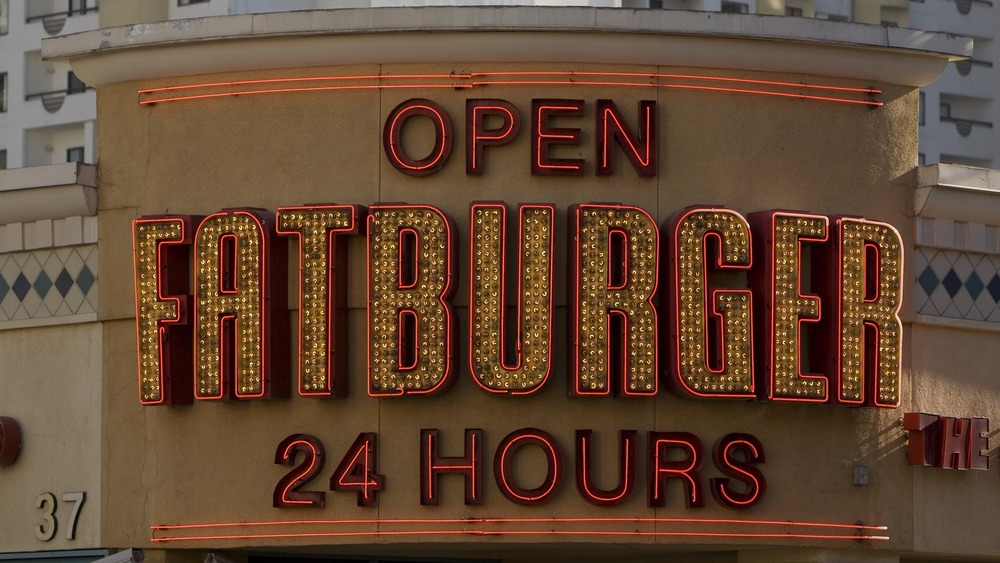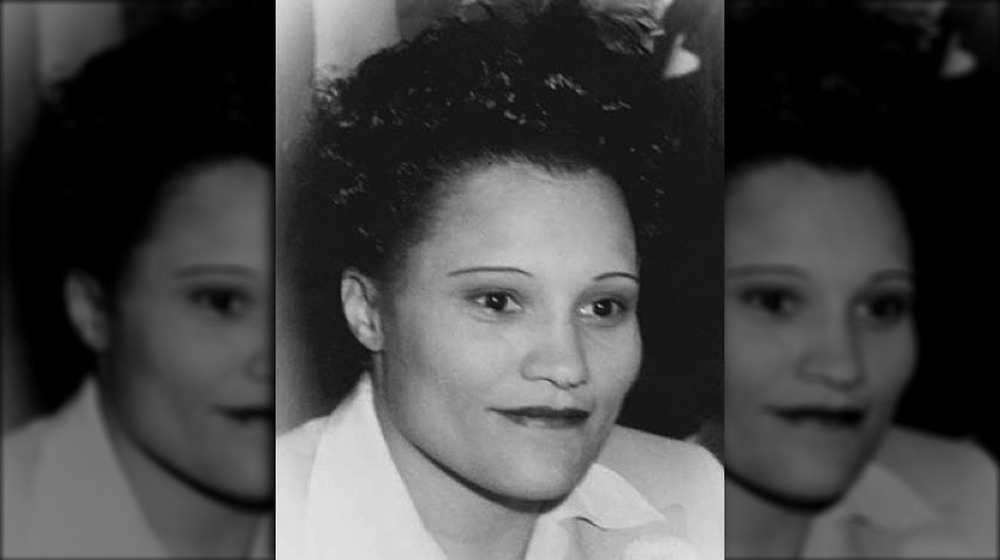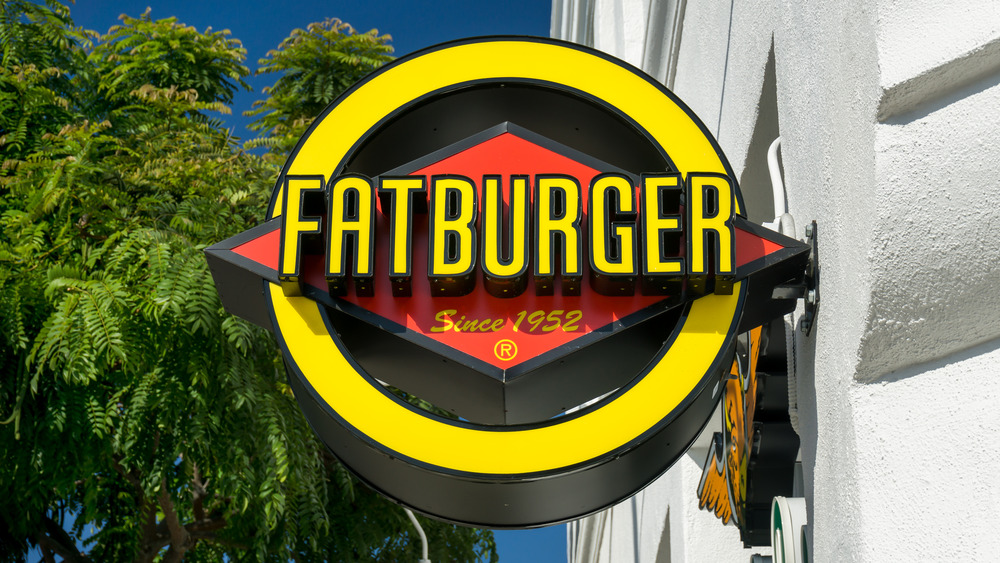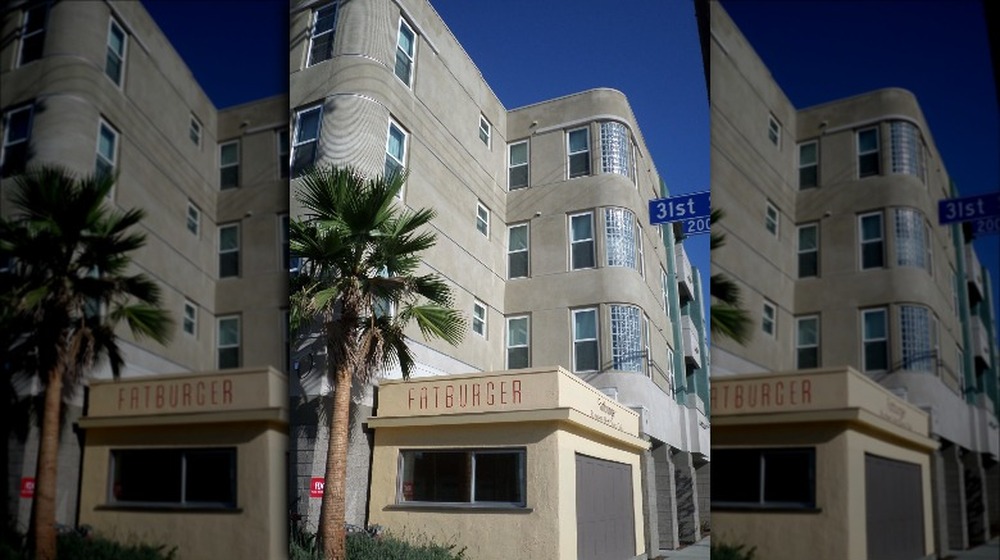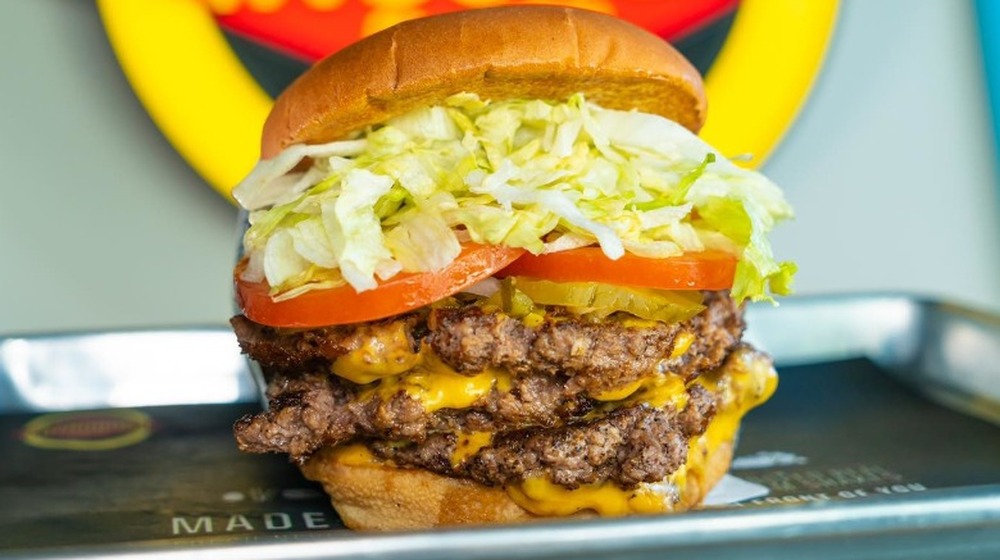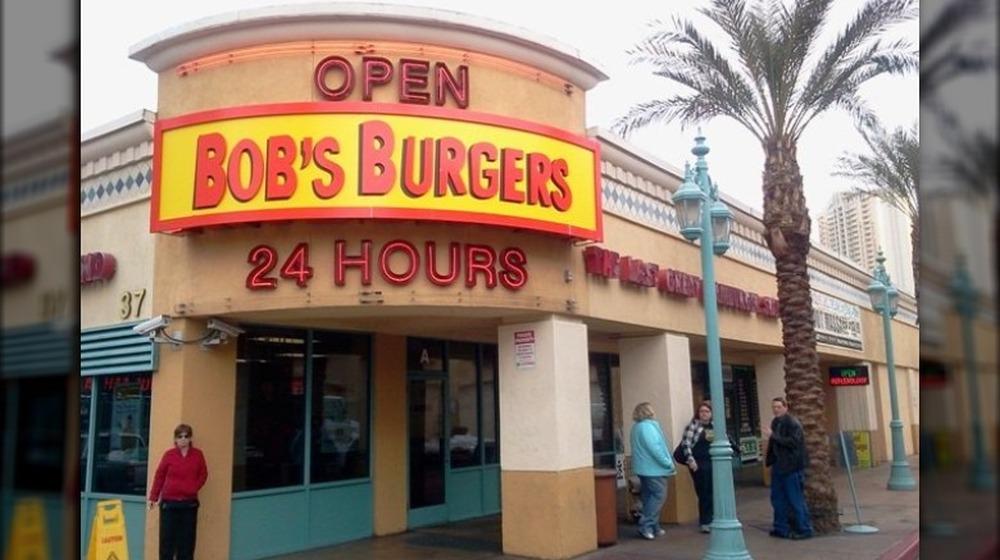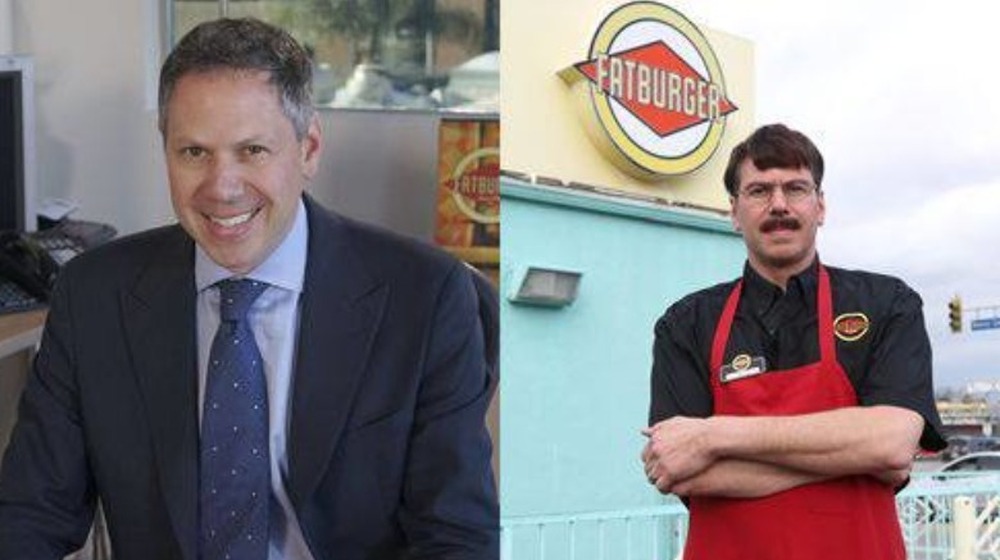The Untold Truth Of Fatburger
Billing itself as the "Last Great Hamburger Stand," Fatburger is a West Coast legend. With 180 locations around the world (154 of them in the U.S. and Canada, according to Fatburger), the chain regularly shows up on local "best burger" lists, not to mention in friendly debates among your burger-loving friends and meat eaters everywhere.
Fatburger founder Lovey Yancey once explained the origin of the distinctive moniker for her restaurants. "The name of the store was my idea, I wanted to get across the idea of a big burger with everything on it...a meal in itself," she revealed (via Fatburger). Hard to argue with that! These burgers start at 1/3 pound, and Fatburger's standard toppings are anything but. They feature a sourdough bun, mayo, lettuce, tomato, pickles, onions, relish, and mustard on top of the patty. Cheese of course is optional, and surprisingly is located between the burger and the bottom bun. Oh, and there's another unique add-on for a fast foot burger joint: Fatburger offers an optional, perfectly rich and oozy fried egg, which Fatburger loyalists insist is essential (via Serious Eats).
Ready for some more fun facts about Fatburger? Here we go.
Fatburger started as a minority, female-owned business.
Fatburger was founded by Lovie Yancey, who was a natural-born entrepreneur, according to the company. Yancey was born in 1912 in rural Bastrop, Texas. Shortly after the birth of her first child in 1931, the single mom moved to of Los Angeles, where better opportunities, she was certain, awaited her. She met a construction contractor named Charles Simpson, and in 1947, using leftover materials from Simpson's other projects, the couple built a three-stool hamburger stand in South Central Los Angeles they called "Mr. Fatburger." Though Lovie always said the "fat" referred to the heft of the burgers, Travel Noire says the term aligned with the slang of the day, when "fat" meant "best" or "supreme."
The pair opened three more locations by 1952. Shortly thereafter, the couple went their separate ways, and Yancey kept the business. Yancey dropped the "Mr." that year.
Yancey was relentless, working 16-hour shifts every day. Her restaurants became a huge success, and by 1973, she counted Redd Foxx, James Brown, and Ray Charles among her most loyal customers (via Mental Floss). Then in 1985, Yancey began franchising Fatburger locations. And in 1986, the wealthy entrepreneur donated $1.7 million to City Of Hope for sickle-cell anemia research, in order to honor her grandson who died of the disease (via Los Angeles Times). Yancey sold the majority of the Fatburger business in 1990, retaining only the original location in South Central California.
Celebrities love Fatburger
The list of stars who are fans of Fatburger is long and includes Nicki Minaj, Justin Bieber, and David Letterman (via the Los Angeles Times), as well as Jay Leno and Milla Jovovich (via Food Network). Shout-outs to Fatburger can be heard in the work of several big-time rappers, too. According to Mental Floss, Ice Cube referenced getting a late-night Fatburger in his track "It Was a Good Day." Tupac spent part of a night out making a Fatburger stop in "Late Night." In "Going Back to Cali," Notorious B.I.G. chronicled a "romantic" encounter in a Fatburger (via Eater).
Even bigger celebs have gone into business with Fatburger. In 2001, Magic Johnson led a group of investors to purchase the then-47 unit chain (via the Los Angeles Business Journal) before selling it two years later. Celebrities including Pharrell Williams, Kanye West, Montel Williams, and Queen Latifah have all owned Fatburger franchises, according to Mental Floss, which adds that Queen Latifah generated some negative publicity when she took a gig as spokesperson for weight loss brand Jenny Craig while owning the decadent burger joint. You can see one of those 2008 ads on YouTube.
The original Fatburger is now affordable housing
Lovie Yancey and her former partner, Charles Simpson, founded the first fatburger on Western Avenue near Jefferson Park in South Central Los Angeles. According to Curbed Los Angeles, because the city named it a historic landmark, the little building can't be destroyed, even to create something the neighborhood desperately needed: safe, affordable housing for low-income families and those living with HIV/AIDS (via L.A. County, Second District).
However, the project's developer and the city found a way to incorporate and honor the historic significance of Yancey's accomplishment and Fatburger's cultural significance to LA. "FATBURGER" is spelled out on the building at the site of the original restaurant. Announcing Jefferson Park Terrace in 2014, the developers said preserving the location was important, as it serves as "a beacon of Black entrepreneurship in a neighborhood on the upswing" (via Curbed Los Angeles). The 60-unit art-deco style building features 60 apartments and a computer room for its residents, a community center, and a playground.
Fatburgers are perhaps the biggest burgers in the business
Fatburgers are "hand-pressed" on the griddle, which the company says makes them taste better. A video from a Beijing franchise (via The Beijinger) shows the burger hitting the griddle in the form of a meatball (although other franchises seem to start with the ground meat in the shape of a thick disk, according to Serious Eats). The ball or disk is then flattened with a grill press. Why not just start with a pre-formed patty? The pressing makes a difference because the process yields irregular "craggy" edges on the burger. These rough edges char to crispy perfection and give Fatburgers their texture.
Speaking of Fatburger's meat, the chain offers what is probably the biggest burger of any fast food chain. The XXXL Kingburger (spoken as "triple kingburger") has three patties and a total of one-and-a-half pounds of beef. You might want to consider splitting it with a friend, however. Depending on how you top it, the XXXL Kingburger has between 1668 and 2050 calories. Just watch this reviewer on YouTube attempt to make a dent in this behemoth, which is nearly the size of his head.
Fatburgers were Bob's Burgers for a day
In 2011, to promote the launch of its animated sitcom Bob's Burgers, Fox Broadcasting partnered with Fatburger to promote the show with a free food giveaway (via Variety). "Bob's Burgers" takes place in a fictional fast food restaurant. To bring it to life, Fox paid Fatburger locations across the country to away free burgers for a day. Select restaurants in Los Angeles, Las Vegas, Chicago, and New Jersey were actually rebranded by Fox as "Bob's Burgers" for an entire month, featuring temporary signage and cardboard character cutouts. Even the packaging, such as cups and burger wrappers bore the Bob's Burgers brand, much to the delight of Bob's Burgers fans.
It wasn't the first time the network held such a publicity event. Variety points out that Fox rebranded several 7-11 convenience stores into "Kwik-E Marts" in honor of their iconic show "The Simpsons."
The CEO was an "Undercover Boss"
Remember the CBS reality show Undercover Boss? In 2013, Fatburger CEO Andy Wiederhorn went incognito for the show at one of the chain's Arizona locations. At the time, Wiederhorn told the East Valley Tribune newspaper he wanted a view of the operation he wouldn't get "if I walked in [wearing] a suit." Wiederhorn purchased the Fatburger chain in 2003, and was named to the top job in 2006. Fatburger's Arizona stores had been struggling in the time leading up to the show, leading to the undercover visit to the Mesa restaurant.
Wiederhorn's costume included a wig, a eyeglasses, a fake mustache and eyebrows, some gold jewelry, and a hat. He spent the day doing everything Fatburger a team member does: grilling burgers, working the cash register, waiting on customers, mixing milkshakes, and even scrubbing dishes. Luckily, Wiederhorn had worked in his family's restaurant as a teenager and caught on quickly.
Of the show's big reveal — that is, learning their new employee was actually their highest-ranking boss — store manager Steve Ziemer said, "It was shocking." He added, "It was also cool to know that somebody in corporate was able to see... the effort that we put in." After participating in the show, Wiederhorn instituted programs to improve communication between restaurant employees and top management.
